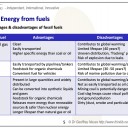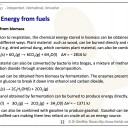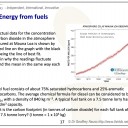R1.3 Energy from fuels


 Energy from fuels
Energy from fuels
Written specifically for students to provide help and support for the IB Diploma chemistry programme this page provides full coverage of the syllabus content of Topic R1.3 Energy from fuels. It encourages you to think critically and provides many questions with fully worked answers so that you can monitor and improve your knowledge and understanding.
Guiding Question
What are the challenges of using chemical energy to address our energy needs?
Learning outcomes
After studying this topic you should be able to:
Understand: 
- reactive metals, non-metals and organic compounds undergo combustion reactions when heated in oxygen.
- incomplete combustion of organic compounds, especially hydrocarbons, leads to the production of carbon monoxide and carbon.
- fossil fuels, which include coal, crude oil and natural gas, have different advantages and disadvantages.
- biofuels are produced from the biological fixation of carbon over a short period of time through photosynthesis.
- a fuel cell can be used to convert chemical energy from a fuel directly to electrical energy.
Apply your knowledge to:
- deduce equations for reactions of combustion, including hydrocarbons and alcohols.
- deduce equations for the incomplete combustion of hydrocarbons and alcohols.
- evaluate the amount of carbon dioxide added to the atmosphere when different fuels burn.
- understand the link between carbon dioxide levels and the greenhouse effect.
- understand the difference between renewable and non-renewable energy sources.
- consider the advantages and disadvantages of biofuels.
- deduce the half-equations for the electrode reactions in a fuel cell.
Consider links to other topics
Which species are the oxidizing and reducing agents in a combustion reaction?
Why is high activation energy often considered to be a useful property of a fuel?
What might be observed when a fuel such as methane is burned in a limited supply of oxygen?
How does limiting the supply of oxygen in combustion affect the products and increase health risks?
Why do larger hydrocarbons have a greater tendency to undergo incomplete combustion?
Why is carbon dioxide described as a greenhouse gas?
What are some of the environmental, economic, ethical and social implications of burning fossil fuels?
What are the main differences between a fuel cell and a primary (voltaic) cell?
Relationships & vocabulary
Nature of Science
When a major technology is changed how certain can we be that the new technology will not cause as many (but maybe different) problems as the old one?International-mindedness
For examples and more links of Incorporating IB chemistry into a real world context see Putting Topic R1 - What drives chemical reactions? - into context.Vocabulary
| specific energy | carbon fixation | biofuel |
| non-renewable fuel | complete/incomplete combustion | fuel cell |
Flashcards
Learning slides
You can use this slide gallery for learning or for reviewing concepts and information. It covers all the key points in the syllabus for this sub-topic.
Something to think about
The first crude fuel cells were actually invented as long ago as 1838 by William Grove, a Welshman and independently by Christian Schönbein from Germany.
It was the NASA space programme that really developed them to become a viable technology. The space shuttle contains three fuel cells, which operate as independent power sources. These use oxygen and hydrogen gas and an electrolyte of potassium hydroxide. Each one is capable of supplying 12 kW peak and 7 kW maximum continuous power supply which is ample for the average power consumption of the shuttle. As well as providing electrical power and heat, the product, water, is used by the astronauts for drinking.
.png)
Cut-away of the Toyota Mirai showing the fuel cell stacks beneath the driver and passenger seats.
Only now are fuel cells being seriously used to power cars. The Toyota Mirai, has a range of about 400 miles (650 km) from a full tank. The first cars went on sale in the US in August 2015. The relatively high cost and the current lack of hydrogen fuel stations are the two main initial hurdles that still need to be overcome. Ultimately vehicles powered by fuel cells (FCVs) may well prove to be the best answer to providing transport for the masses that does not rely on fossil fuels and so significantly reduce the emission of polluting greenhouse gases.
Hydrogen fuel cells are used much more widely to power heavy vehicles as the vehicles are more able to accommodate the fuel tanks. The first trains powered by hydrogen fuel cells are also being researched in the UK and made their first journey in September 2020.

Hydrogen powered train
Test your understanding of this topic
Practice questions available to you immediately:
You have direct access to ten multiple choice practice questions with the answers explained see: Practice questions: R1.3.
Possible restricted access questions:
(Note that your teacher may have restricted your access to some or all of these questions and worked answers if they are going to use them as a class test or set them as an assignment.)
For ten 'quiz' multiple choice questions with the answers explained see MC Test: R1.3 Energy from fuels.
For short-answer questions R1.3 Energy from fuels questions.
Other resources
1. 
OUP Study Guide (Neuss): Pages 80 - 83
2. Ten future energy sources that can replace fossils fuels.
3. A Guardian video giving three good reasons as to why we need to keep fossil fuels in the ground.
Why we need to keep fossil fuels in the ground
4. A useful site from Energy4me comparing the pros and cons of different energy sources.
5. The Green Ninja advises on how to reduce your carbon footprint.
Green Ninja: Footprint renovation
6. An animated overview of fuel cells by the Naked Science Scrapbook which provides a good introduction to the different types of fuel cells and why they are useful (but does not include the half-equations).
7. A good exercise from NASA on fuel cells.

You can download the student worksheet for this exercise.






































